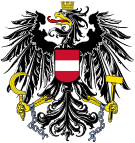1938 Austrian Anschluss referendum
| ||||||||||||||||||||||
"Do you agree with the reunification of Austria with the German Reich that was enacted on 13 March 1938 and do you vote for the list of our leader Adolf Hitler?" | ||||||||||||||||||||||
| Results | ||||||||||||||||||||||
|---|---|---|---|---|---|---|---|---|---|---|---|---|---|---|---|---|---|---|---|---|---|---|
| ||||||||||||||||||||||
| This article is part of a series on the |
| Politics of Austria |
|---|
 |

A referendum on the Anschluss with Germany was held in German-occupied Austria on 10 April 1938,[1] alongside one in Germany.[2] German troops had already occupied Austria one month earlier, on 12 March 1938. The official result was reported as 99.73% in favour,[3] with a 99.71% turnout.[4]
Background
After the end of World War I, the newly founded Austria, which claimed sovereignty over the majority-German territory of the former Habsburg empire. According to its provisional constitution it declared to be part of the also newly founded German Republic. Later plebiscites in Tyrol and Salzburg in 1921, where majorities of 98,77%[5] and 99,11%[6] voted for a unification with Germany, showed that it was also backed by the population.
In September 1919 Austria had to sign the Treaty of Saint Germain, which did not only mean significant losses of territory but it was also forced to change its name from "German Austria" to "Austria". Furthermore, Article 88 of the treaty stated that "the independence of Austria is inalienable otherwise than with the consent of the Council of the League of Nations", to prevent any attempt to unite with Germany.
Campaign
During the lead-up to the referendum, Hitler's campaign included anti-Catholic and anti-Semitic posters. Campaign managers reported "no opposition to the referendum". The referendum was supported by the Social Democratic Party of Austria, whose leader Karl Renner endorsed Hitler on 3 April, and Cardinal Theodor Innitzer, the highest representative of the Roman Catholic church in Austria.[7]
Results
The referendum question was:
Do you agree with the reunification of Austria with the German Reich that was enacted on 13 March 1938 and do you vote for the list of our leader Adolf Hitler?
| Choice | Votes | % |
|---|---|---|
| For | 4,453,912 | 99.73 |
| Against | 11,929 | 0.27 |
| Invalid/blank votes | 5,777 | – |
| Total | 4,471,618 | 100 |
| Registered voters/turnout | 4,484,617 | 99.71 |
| Source: Direct Democracy | ||
Although there were irregularities, LIFE in 1938 acknowledged that the results of the referendum and its German counterpart were "largely honest"[8] Some postwar accounts claim that the poll was rigged, but there is no evidence that this was necessary.[9] The result was "... the outcome of opportunism, ideological conviction, massive pressure, occasional vote rigging and a propaganda machine that Austria's political culture had never before experienced."[10] The massive pressure to which people were exposed came from the fact that many were marking the ballot paper in front of the campaign workers in order not to be suspected of voting against the Anschluss.[11] The secrecy of the ballot was in practice non-existent.[12]
References
- ^ Nohlen, D & Stöver, P (2010) Elections in Europe: A data handbook, p176 ISBN 978-3-8329-5609-7
- ^ Nohlen & Stöver, p762
- ^ Austria, 10 April 1938: Anschluss with Germany, Reichstag list Direct Democracy Template:De icon
- ^ The propagandistic preparation for the referendum Documentation Centre of Austrian Resistance Template:De icon
- ^ 24. April 1921: Anschluss with Germany Direct Democracy Template:De icon
- ^ 29. Mai 1921: Anschluss with Germany Direct Democracy Template:De icon
- ^ Bukey, Evan Burr (2000). Hitler's Austria : popular sentiment in the Nazi era, 1938-1945. Chapel Hill, N.C.: University of North Carolina Press. p. 36. ISBN 0807853631.
- ^ "Germans from England - "Ja" on a Special Trip Out to Sea". Life. 1938-05-02. p. 21. Retrieved November 28, 2011.
- ^ Bukey 2000, p. 34
- ^ Günther Bischof, Fritz Plasser, Barbara Stelzl-Marx eds. 2009. New Perspectives on Austrian and World War II. In: Contemporary Austrian Studies , Volume 17. New Brunswick. p.11.
- ^ Wilhelm J. Wagner: Der große Bildatlas zur Geschichte Österreichs. Kremayr & Scheriau, 1995, (chapter „Heim ins Reich“).
- ^ Sandra Paweronschitz. 2006. Zwischen Anspruch und Anpassung. Journalisten und der Presseclub Concordia im Dritten Reich. Wien. p.21


